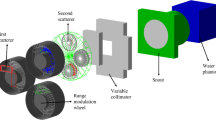Abstract
The use of a multi-layer ionization chamber, Zebra, in patient-specific quality assurance (QA) for proton depth dose distributions in a single-ring wobbling method is investigated. The depth dose distributions measured using Zebra are compared with those calculated using the treatment planning system (TPS), XiO-M, and measured using an ionization chamber with a motorized water phantom system. Because the TPS only provides point doses, the average doses are calculated using in-house software. The detector size-corrected depth dose distributions are obtained by determining the average of the dose distributions from the TPS over a cylindrical region similar to the size of the Zebra detectors. The calculated depth dose distributions from the cases with a simple compensator shape are in good agreement with those obtained from the TPS without performing volume averaging; however, a 15% difference was shown when compared with those from the cases with a complex compensator shape. Then, the measurements are compared with the detector size-corrected depth dose distributions, showing an improved agreement within 3% for the highly steep dose gradient regions. Although there are some field size limitations, the Zebra system is a useful device for the fast measurement of patient-specific QA for depth dose distributions in wobbled proton beams. However, careful consideration is required for complex dose distribution fields, because the measurements obtained using Zebra cannot be directly compared to the depth dose distributions from the TPS owing to the finite detector size of the Zebra chamber.




Similar content being viewed by others
References
IAEA. Absorbed dose Determination in External Beam Radiotherapy-An international Code of Practice for Dosimetry based on Standards of Absorbed Dose to Water Technical Report Series No 398. Vienne: International Atomic Energy Agency; 2000.
Nichiporov D, Solberg K, Hsi W, His W, Wolanski M, Mascia A, Farr J, Schreuder A. Multichannel detectors for profile measurements in clinical proton fields. Med Phys. 2007;34:2683–90.
Yajima K, Kanai T, Kusano Y, Shimojyu T. Development of a multi-layer ionization chamber for heavy-ion radiotherapy. Phys Med Biol. 2009;54:N107–14.
Dhanesar S, Sahoo N, Kerr M, Taylor B, Summers P, Zhu XR, Poenisch F, Gillin M. Quality assurance of proton beams using a multilayer ionization chamber system. Med Phys. 2013;40:092102.
Rinaldi I, Brons S, Jäkel O, Voss B, Parodi K. A method to increase the nominal range resolution of a stack of parallel-plate ionization chambers. Phys Med Biol. 2014;59:5501–15.
Takayanagi T, Nihongi H, Nishiuchi H, Tadokoro M, Ito Y, Nakashima C, Fujitaka S, Umezawa M, Matsuda K, Sakae T, Terunuma T. Dual ring multilayer ionization chamber and theory-based correction technique for scanning proton therapy. Med Phys. 2016;43:4150–62.
Mirandola A, Magro G, Lavagno M, Mairani A, Molinelli S, Russo S, Mastella E, Vai A, Maestri D, Rossa V, Ciocca M. Characterization of a multilayer ionization chamber prototype for fast verification of relative depth ionization curves and spread-out-Bragg-peaks in light ion beam therapy. Med Phys. 2018;45:2266–77.
Schippers JM, Lomax AJ. Emerging technologies in proton therapy. Acta Oncol. 2011;50:838–50.
Koehler AM, Schneider RJ, Sisterson JM. Flattening of proton dose distributions for large-field radiotherapy. Med Phys. 1977;4:297–301.
Himukai T, Takada Y, Hotta K, Hara Y, Komori M, Kanai T, Kohno R. Analytical design method of optimum ridge filters for wobbled and collimated proton beams. Jpn J Med Phys. 2008;28:57–69.
Kase Y, Yamashita H, Numano M, Sakama M, Mizota M, Maeda Y, Tameshige Y, Murayama S. A model-based analysis of a simplified beam-specific dose output in proton therapy with a single-ring wobbling system. Phys Med Biol. 2015;60:359–74.
Tansho R, Takada Y, Kohno R, Hotta K, Hara Y, Mizutani S, Akimoto T. Experimental verification of dose calculation using the simplified Monte Carlo method with an improved initial beam model for a beam-wobbling system. Phys Med Biol. 2013;58:6047–64.
Yonai S, Kanematsu N, Komori M, Kanai T, Takei Y, Takahashi O, Isobe Y, Tashiro M, Koikegami H, Tomita H. Evaluation of beam wobbling methods for heavy-ion radiotherapy. Med Phys. 2008;35:927–38.
Lomax AJ, Böhringer T, Bolsi A, Coray D, Emert F, Goitein G, Jermann M, Lin S, Pedroni E, Rutz H, Stadelmann O, Timmermann B, Verwey J, Weber DC. Treatment planning and verification of proton therapy using spot scanning: initial experiences. Med Phys. 2004;31:3150–7.
Author information
Authors and Affiliations
Corresponding author
Ethics declarations
Conflict of interest
The authors declare that they have no conflict of interest.
Ethical approval
This article does not contain any studies with human participants and animals performed.
Additional information
Publisher's Note
Springer Nature remains neutral with regard to jurisdictional claims in published maps and institutional affiliations.
About this article
Cite this article
Kato, T., Arai, K., Sagara, T. et al. Patient-specific quality assurance for proton depth dose distribution using a multi-layer ionization chamber in a single-ring wobbling method. Radiol Phys Technol 12, 305–311 (2019). https://doi.org/10.1007/s12194-019-00524-8
Received:
Revised:
Accepted:
Published:
Issue Date:
DOI: https://doi.org/10.1007/s12194-019-00524-8




